
|
||
|
Issue 53 |
|
25 February 2009 |
|
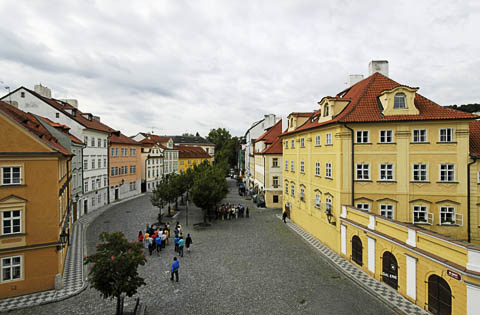 Prague Announcements
The BooksCarfree Design Manual will be released in North America on 1 April 2009. The sites listed below are accepting pre-orders:
Open Source Carfree Software ProjectI had hoped to have something definite to report on carfree software development by this time, but little progress has been made. If you have any interest in helping to develop software to model the efficiency of cities in general and carfree cities in particular, please send me e-mail. Likewise, if you are interested in developing software to create 2D and 3D models, please let me know. I have not yet had time to test the new City Engine from Procedural. First step will probably be to set up a discussion list. I'll try to get this moving soon.Photo ContestI'm running low on good photographs of carfree urban areas. Please e-mail photographs that you would like to publish in the next issue of Carfree Times. The prize is. . . a free copy of Carfree Times and enduring fame (plus copyright notice if you prefer).World Carfree NetworkAfter a difficult year, World Carfree Network is back in substantial operation. Publication of Car Busters continued through the difficulties. They could use a hand if you have time or money to spare.CNU 17Carfree.com is a sponsor of CNU 17: "Experiencing the New Urbanism:The Convenient Remedy." to be held 10-14 June 2009 in Denver. From the conference web site: "The annual Congress for the New Urbanism (CNU) is the leading venue for new urbanist education, collaboration, and networking. CNU members come from around the world to discuss development practices and public policies, learn from recent innovative work, and advance new initiatives to transform our communities." I have never been to a CNU conference and would like very much to have someone representing the carfree point of view at one of these conferences. A report for Carfree Times would be most welcome. Sustainable Urban DesignDr. Jan Scheurer, a long-time advocate for carfree cities, advises that a four-day course, Urban Design for Sustainability, will be held at the Urban Design Centre of Western Australia (Perth) 14-17 April 2009. Professional participants will be joined by students. For more information, visit the web site.
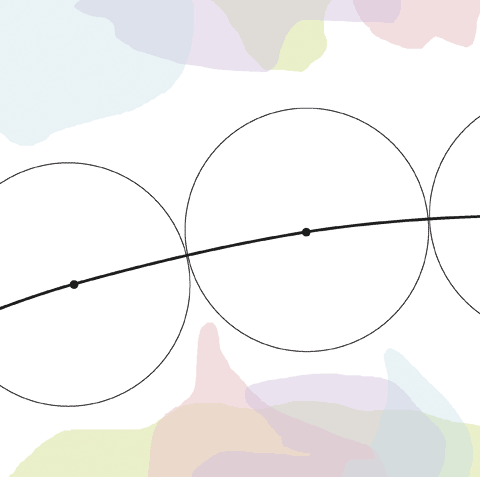 Districts Sited
The limiting conditions, shown in various colors, dictate where districts can be located. At this stage, the location
of the transport line and the extent of each district have been established. The populations of each district will be
known within close limits. This part of the design is reached using conventional urban planning techniques, including
citizen participation.
Evolution of a Carfree DistrictCarfree Design Manual proposes new processes to allocate land in carfree districts to families and organizations. That task is complex and involves extensive use of computers. It is difficult to present in graphical form.The book also proposes new on-site design methods that are intended to replicate the evolved character and response to human needs that characterize medieval urban areas. However, the tempo is shortened from centuries to weeks. The method is low-tech in the extreme: it relies mainly on string and people. I have illustrated this issue with some of the drawings from the new book. The captions give a brief explanation of the changes from the previous design state. For reasons of space, about half of the drawings have had to be omitted here.
QuotableMany say that a reduction in air pollution would make the single biggest difference to their quality of life.
Dr Elaine Vickers |
News Bits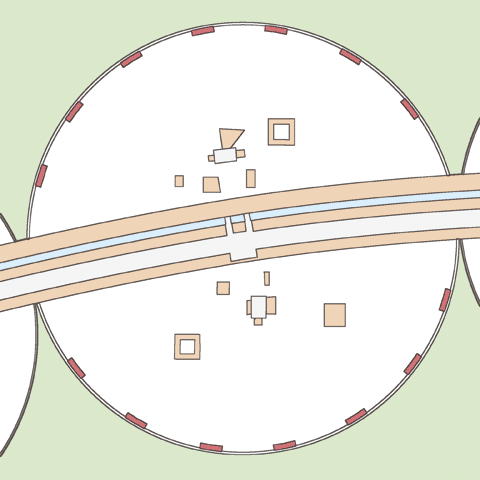 Radial Street Terminations & Major Uses
At this point, major buildings and squares have been identified. Their precise location and
design are not yet known. The red stripes indicate the possible ranges for the terminations
of major radial streets.
Apocalypse Now?The latest news on climate change is the worst ever. At a conference in the UK this summer, climate researcher Kevin Anderson delivered the gloomy news. Carbon emissions are soaring out of control, reaching levels far higher than the worst scenarios considered by the 2007 IPCC report. Anderson thinks the battle against climate change had been lost. We need to prepare for a very bad outcome.Top UK climate scientists sat in stunned silence as Anderson showed that carbon emissions since 2000 have risen much faster than anyone had thought possible. Coal is the major culprit. CO2 levels are now likely to rise to 650 parts per million (ppm) from today's 380 ppm. Most governments want to limit the rise to 450 ppm. At 650 ppm, the world faces a catastrophic 4C average temperature rise. And even that bleak future can only be achieved if rich countries adopt "draconian emission reductions within a decade". Even the current economic crisis won't help much. Many scientists, politicians, and campaigners now admit privately that 2C is a lost cause. 650 ppm is now viewed as a more likely outcome than 450 ppm. Hitting the 450 ppm target is now seen as "unbelievably difficult." To limit CO2 to 450 ppm, rich nations would have to cut carbon dioxide emissions by 5% a year over the next decade. Britain's Climate Change Act 2008, is the world's most ambitious legislation, and it calls for reductions of 3% a year for 40 years.
"Too Late? Why Scientists Say We Should Expect the Worst"  Preliminary Arrangement of Major Radial Streets
The basic topology of the major streets has been determined. This includes the
branching of these streets, as not all of them can be brought to a central location due to space constraints.
Kids See the LightJapanese kids are spurning cars. They're getting around by skateboard or train and have no desire to buy cars. Cars are just more trouble than they're worth.The phenomenon is common enough that Japanese car makers have coined a term for it: "kuruma banare" ("demotorization"). Many in this generation do not regard cars as status symbols. "Young people's interest is shifting from cars to communication tools like personal computers, mobile phones and services," said Yoichiro Ichimaru, chief of domestic sales for Toyota. The Japan Automobile Manufacturers Association predicts auto sales in Japan will fall to 4.86 million in 2009, the first time sales would fall below 5 million in more than three decades, down from a peak of 7.78 million during the 1990 bubble. The manufacturers haven't given up. Nissan Chief Operating Officer Toshiyuki Shiga said, "The change in young people's attitude toward cars didn't happen overnight. So we have to keep convincing them cars are great." I predict that it's going to be a hard sell.
"Cars no longer coveted by young 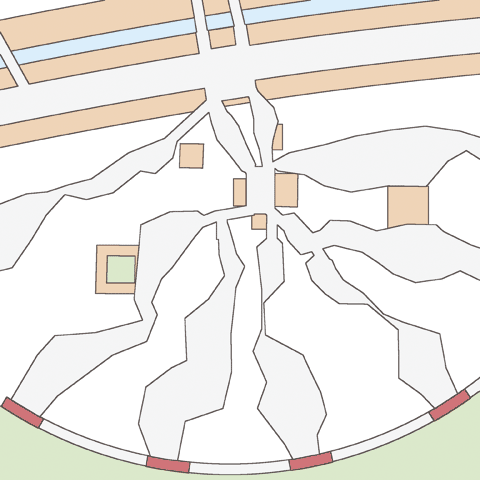 Envelope for Major Radial Streets
Future occupants of each side of each radial street independently select an alignment for their side of the street.
In some places, streets will be far too wide. In other places, the streets may have zero width.
Your Brain on CarsScientists often ask the wrong question. In a recent Boston Globe article, research into the mental reaction of people to urban and natural environments was reported. However, the cities studied were the usual auto-centric nightmares: noisy, stinky, and full of speeding cars. What the researchers did not include was how people react in dense urban environments that have no cars, such as Venice. I'll pick some of this apart.One of the main forces at work is a stark lack of nature, which is surprisingly beneficial for the brain. Studies have demonstrated, for instance, that hospital patients recover more quickly when they can see trees from their windows, and that women living in public housing are better able to focus when their apartment overlooks a grassy courtyard.I even cited the hospital study in Carfree Design Manual. However, I think that what is at work here is, at least in part, the lack of fractal patterns that the brain processes most easily. Auto-centric streetscapes, especially those lacking trees and crowded by Modern buildings, are especially poor in fractal objects. Cars are among the least fractal objects we have created. Nearly all buildings more than a century old are fractal in their design, but Modern architecture is exceptionally poor in fractal elements. (See the work of Nikos Salingaros.) Consider everything your brain has to keep track of as you walk down a busy thoroughfare like Newbury Street [Boston]. There are the crowded sidewalks full of distracted pedestrians who have to be avoided; the hazardous crosswalks that require the brain to monitor the flow of traffic.Of course, the sidewalks would not be so crowded if pedestrians could use the full width of the street. I suspect, too, that further research would show that the stress builds not from avoiding pedestrians but from staying out of the paths of speeding cars, which, unlike the pedestrians, pose a real threat. People are themselves highly fractal objects. A city is so overstuffed with stimuli that we need to constantly redirect our attention so that we aren't distracted by irrelevant things, like a flashing neon sign or the cellphone conversation of a nearby passenger on the bus. This sort of controlled perception - we are telling the mind what to pay attention to - takes energy and effort.Again, the heaviest demands are related to cars, especially their noise. We tend to think of cities as noisy places, but in cities like Venice the sounds of hundreds or thousands of people talking, in the absence of the usual urban noise burden, are not only restful but even reassuring. This has to be experienced to be believed. Imagine a walk around Walden Pond, in Concord. The woods surrounding the pond are filled with pitch pine and hickory trees. Chickadees and red-tailed hawks nest in the branches; squirrels and rabbits skirmish in the berry bushes. Natural settings are full of objects that automatically capture our attention, yet without triggering a negative emotional response - unlike, say, a backfiring car. The mental machinery that directs attention can relax deeply, replenishing itself.Yes, undoubtedly true (and notice the reference to a backfiring car, an alarming sound). It is for this reason that I wish to provide green space in the courtyard of each block. I noticed this effect when I lived in Amsterdam. By turning my head while at my desk, I could see a rich, relaxing natural landscape out the back window, even as the noise of cars roared in through the front window.
"How the city hurts your brain" 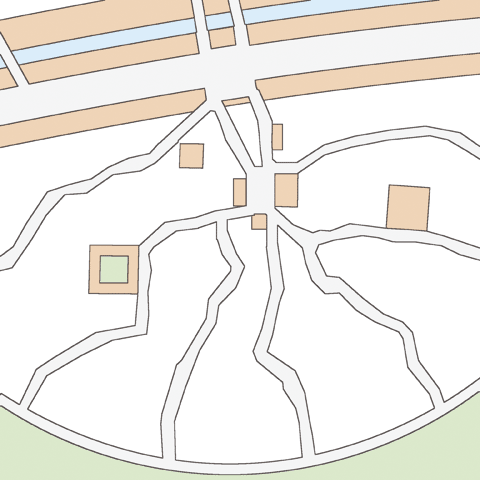 Major Radial Streets Defined
A process of on-site negotiation refines the location and width of each major radial street.
Subtle adjustments will follow in later phases.
Sprawling EuropeAmerican-style suburban sprawl has infected Europe. And, just as in the USA, the New Urbanism is increasingly seen in Europe as a way to return to mixed-use, low-carbon communities that are friendly to pedestrians, cyclists, and public transport users. There was a feeling at the International Conference on Climate Change and Urban Design in Oslo this past September that their time has come.Just as in the USA, people are disenchanted by Corbusier-inspired large-scale housing blocks. They want a return to the scale and density that gave each European city, town, and village its own distinctive character. They hope for a return to cities where business, industry, shops, and residences share meandering streets suitable for walking and biking, with nearby public transport. In short, they want a return to cities with a sense of place that celebrates local history, climate, ecology, and vernacular architecture. Until now they have been labeled nostalgic. Even in densely-populated Europe, land outside cities was comparatively plentiful and cheap. Buyers seemed to want large American-style single-family houses. Now that sustainability is on the table, Europe is reexamining the advantages of older urban patterns. Freiburg, Germany, committed to preserving its medieval city center by keeping sprawl at bay. The 5000 dwellings of its new Vauban district are one result. This compact, largely carfree project is energy efficient, and only 15% of households own a car. Most travel is by foot or bike. The conference stressed new data that shows how energy consumption and CO2 emissions are inversely proportional to population density. Low-density construction is the worst of all. And Europe has seen accelerating sprawl across the continent. Green buildings alone are not the answer. Stephen Platt of Cambridge Architectural Research said, "Everyone gets seduced by the 'green bling.' Making the houses energy-efficient is the easy bit. The key problem is making this a long-term socially acceptable place where people will want to live and prosper." We must create places like Vauban that encourage people to change their unsustainable behaviors. A key challenge is seen to be the creation not of "cities in the country" but places that connect to the existing heritage. Regardless of whether these new towns are carfree or car-lite, they must have tight linkages to the historic city centers.
"The New Urbanists: Tackling Europe's Sprawl" 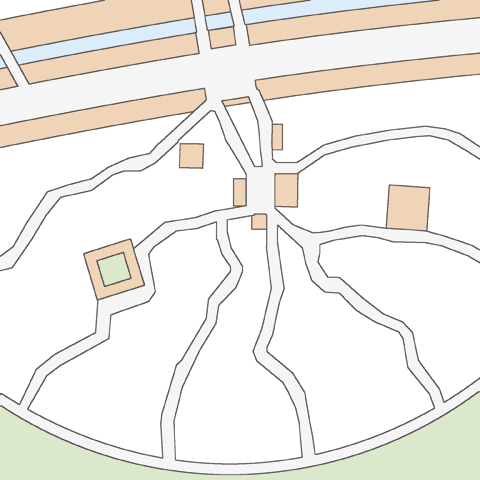 Radial Streets Refined
The square school and its interior courtyard have drawn a street up to it so that two
sides of the school adjoin the street. The street has been widened on the south side of the school.
MasdarThe Masdar district, now under construction in Abu Dhabi, can reasonably be seen as the world's first purpose-built new carfree city. The nation has committed enormous resources to building a high-tech, sustainable city that just happens to be carfree. The TreeHugger blog interviewed Jay Witherspoon, the city's Technology Director, who works for CH2M Hill, a global project management, consulting, and engineering firm. Some of the more interesting bits are excerpted below.TreeHugger (TH): How is Masdar City different from other projects you have worked on in the past?Treehugger also interviewed Luca Guala, a transport planner with Systematica, which designed Masdar's PRT system. The system is integral to the city's design. A light-rail line will connect the city with the airport and the existing city center, which is about 20 km distant. No cars will be allowed into Masdar, but multi-story parking garages will located at its perimeter. TH: Would it be fair to describe PRT as a system of transportation which combines the sustainability of a light rail with the convenience of the private car?It is apparently planned to move cargo in Masdar using dedicated vehicles running on the PRT system. I have been watching Masdar with great interest. Although the city is not likely to be duplicated, due to the high costs that are involved and its location in an extremely hot climate, it will be an important prototype for sustainable carfree cities.
"Masdar is the Catalyst" 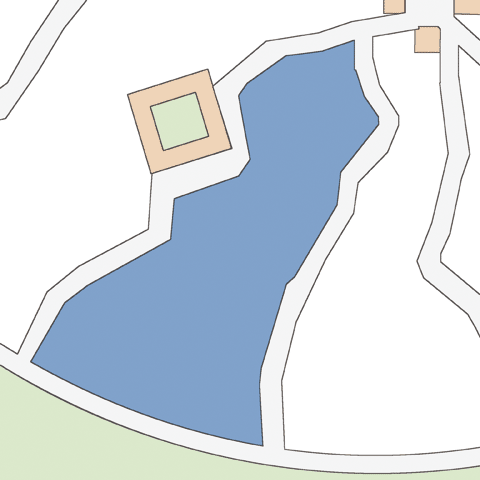 Neighborhood Under Design
Once the major radial streets have been defined in nearly final form, the district will
be designed neighborhood-by-neighborhood. The blue patch delineates one of these neighborhoods. The evolution of
its design is shown in the remaining drawings.
FazilkaIn contrast to the high-tech, top-down approach in Masdar, the Punjabi town of Fazilka is seeing a bottom-up initiative to remove cars from the city center during daylight hours. The town is located near the India-Pakistan border and is thought to be the first place in India to implement a carfree city.Implementation began when the market area was made carfree. Motorized four-wheeled vehicles and heavy vehicles are not allowed to drive in this zone during 12 daytime hours. The town had already undertaken activities to promote non-motorized transport. The change has not just improved the quality of social life but also improved law and order and the environment. Reduced air pollution, a better economy, and improved road safety have been noted. Communities that are friendly to walking and biking are being seen as places with a high quality of life. Municipal Council President Anil Sethi sees the carfree zone as a way to promote non-motorized transport and to build connections between the wealthy parts of town and the poorer parts. He opposes the construction of new overpasses within the city, which is a courageous position in Indian politics today. Eco-cab (Dial-a-Rickshaw) has also been introduced, using the latest intelligent transport tools.
"Fazilka, first to have a Car-free city concept in India" 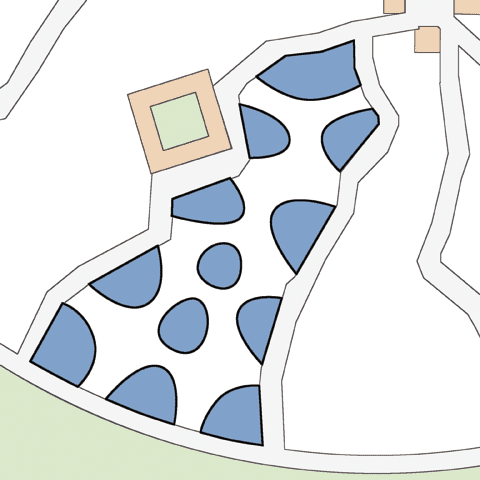 Preliminary Definition of Blocks
During the computerized land allocation process, both social and economic needs are tentatively
optimized by computer. On the basis of this analysis, families and organizations are assigned to
various blocks that are thought to be congenial locations for them. These initial assignments
will be subject to change once people gather on the site to conduct neighborhood design. Locations
are given by frontage strings that represent each building. These strings are arbitrarily shortened by 30%
and will be restored to their full lengths later on. The blue blobs represent each of the
preliminary blocks.
Carfree 42nd StreetPlans to build a 42nd-Street tram have been in the works for years. These plans have evolved, at least in some quarters, to include removing cars from the full length of the street. The tram is heralded as making it possible to move across the island in a "mere 21 minutes." (By bike it ought to take barely half that, but the trams would be limited to just 15 MPH for safety reasons.)The Institute for Rational Urban Mobility unveiled its Vision42 in 1999. The group has given hundreds of presentations, commissioned technical studies, and presented its ideas at community meetings. In the most recent report, Roxanne Warren, the architect who chairs the Vision42 initiative, and George Haikalis, an engineer who presides over the Institute for Rational Urban Mobility, summarized the studies. The line would cost $411.3 million to $582.3 million in 2007 dollars. It would generate $704.9 million in annual economic benefits, and yield $175.4 million a year in additional fiscal benefits to the city and state. (Notice that the capital costs are one-time, and the benefits recur each year.) Property values would rise by $1 billion. Retail business would increase by 35%. Freight has received serious attention. It turns out that most large office buildings along 42nd Street receive their freight on 41st or 43rd Streets. The study also shows that closing 42nd Street to traffic would not shift congestion to other streets. The project could be completed in just two years and financed from the increased tax revenues. Alternatively, a transit-benefit-improvement district could shift the cost to property owners, who would be net beneficiaries. Mayor Bloomberg does not yet support the plan, despite his generally forward-thinking views regarding the balance between pedestrian and car space allocations. Officials at the Metropolitan Transportation Administration (which runs the subways) have expressed an interest.
"42nd Street as a Car-Free Light Rail Corridor" 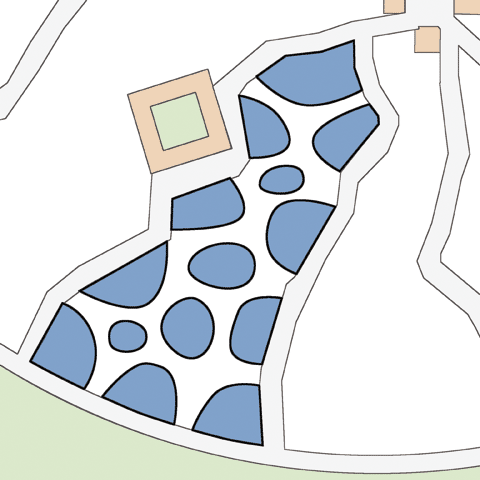 Block Composition Adjusted
The preliminary block assignments are adjusted on the site. People may move from one block
to another or join with others to create entirely new blocks. Changes are made on the basis
of personal preferences.
The USA Saves Railroads. . . For LaterThe American version of "high-speed rail" may be limited to about 100 MPH, if the discussion regarding a system linking Charlotte and Atlanta is any guide. ("Real" high-speed trains are generally considered to be those that exceed 150 MPH, with some systems running as fast as 220 MPH.)The Charlotte-Atlanta system is projected to make a profit if it captures as little as 2% of total trips. This, however, may be difficult given that the end-to-end times will probably not compare favorably with cars for most real-world trips. In Europe and Japan, real high-speed rail projects are taking a lot of traffic away from the airlines. When the first line, from Paris to Lyon, opened about 25 years ago, air traffic on that route all but disappeared. Similarly, Spain's new high-speed lines have captured large numbers of airline passengers and considerably reduced CO2 emissions. High-speed rail has lost out in the economic recovery package. This is probably because "shovel-ready" projects are lacking. But China is going on a rail-building spree. The New York Times has reported that the country "has already built as many miles of high-speed passenger rail lines in the last four years as Europe has in two decades." Rail is a major component of China's recovery plan. Included are $17.6 billion for a passenger line across deserts, $22 billion for freight lines, and $24 billion for high-speed Beijing-Guangzhou passenger service. In my Interstate Rail proposal, I found 100 MPH service to be fast enough to be useful. It has the further advantage of greater energy efficiency than true high-speed service. One part of my proposal would be lowering the speeds for road vehicles to about 50 MPH from the current de-facto 70 MPH. This, of course, improves the competitive position of medium-speed rail while slashing the energy consumption of highway vehicles.
"Not rushing into railroad building" 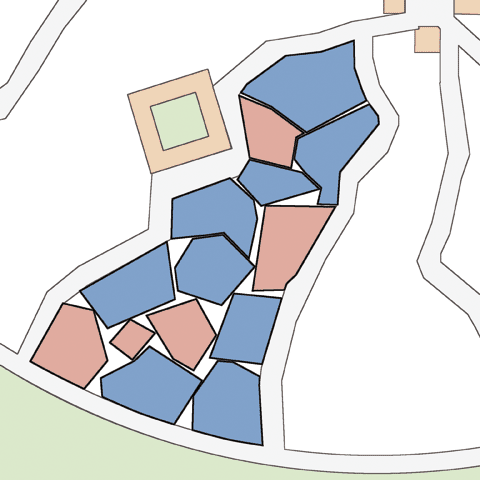 Initial Block Arrangement
The strings are increased to their original lengths. Families and members of organizations stand within
their block, behind the string. All members of each block simultaneously move outward, taking up the slack
in the string, giving definition to the blocks. In the case of the red blocks, the full length of the
string has not yet been taken up.
Wireless Trams, MaybeI've been a promoter of wireless and short-wire trams for quite some time. Tram manufacturers have seen the appeal of the idea (probably not from reading my screeds). Various efforts have already been undertaken, including one in which a central third rail is energized only while the tram is above it.Now Bombardier, the world's biggest tram builder, has introduced a prototype tram that obtains its energy through induction, without any direct contact. The method is to be found, on a much smaller scale, in many households with electric toothbrushes and razors. The tram inductors are only energized when a tram is above. Bombardier claims an efficiency of 98%. The trams would be 20-30% more expensive, but the pay-back is 6-10 years because the cost of maintaining overhead wires and pantographs is considerable. The fly in the ointment is the cost of laying the in-ground inductors, which will themselves require some level of maintenance. The very strong induced currents are likely, in my estimation, to cause a number of problems that can't readily be solved. So, I continue to favor my original proposal, which is simple and cheap.
"'Draadloze' tram verlost steden van bovenleidingen" 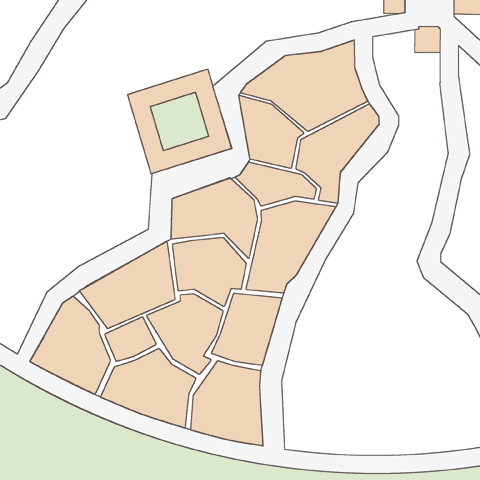 Blocks Adjusted
On-site adjustments are made so that all of the blocks fit on the site, and the full length
of each block's perimeter string has been absorbed. Distant changes may have local effects. Changes
are made by direct negotiation on the site.
Open-Source Urban PlanningLimeWire creator Mark Gorton is bringing open-source principles to urban planning and transportation modeling software. The Open Planning Project has developed open-source origin-and-destination analysis software that can overlay street information sources and help to devise more effective transit routes than has been usual. The transit analysis software interfaces with GeoServer, an open-source, Java-based server that lets anyone access geo-spatial data. Road information can be delivered to anyone who needs the data. Applications like trip-planning software can access the data as well.Gorton wants to put planning tools in the hands of citizen planners. Until now, the expensive and cantankerous software used by transit agencies to do route analysis has only been available to planning and transport professionals. The new software saw its first serious application in Portland, Oregon, which used it to optimize bus routes. The next target is San Francisco, where proprietary software has caused major headaches. One of the ironies of open-source software is that the support is often better than for expensive proprietary software. Gorton sees the following next steps for the livable cities movement:
"LimeWire Creator Brings Open-Source Approach to Urban Planning" |
Editorial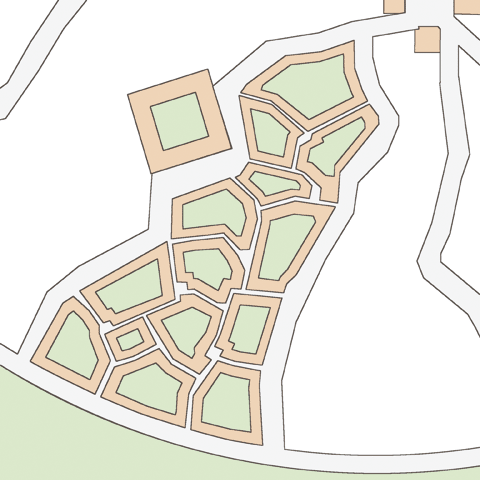 Blocks Refined
Small local squares are introduced. Interior courtyards are delineated on the basis of
earlier agreements regarding the amount of land each family will occupy.
Don't Give Up the ShipJ.H. CrawfordI don't know anyone who is optimistic about the economic crisis that emerged so suddenly during these past few months. The prospects are, indeed, daunting, but I think there is a way out of this mess. The problem is that we aren't headed in the direction of long-term sustainability.Take, for instance, the lead article, which I entitled Apocalypse Now. Yes, it all sounds bad, and CO2 at 650 ppm probably is the end of "life as we know it." But life as we know it hasn't been with us for very long. People born in the 1930s know a completely different reality, one not based on massive consumption but on thrift and durable goods designed to last a lifetime. We must choose between attempting to keep the economy on the same track we have followed since 1945 and averting a catastrophic rise in CO2 levels. The climate scientists see no hope of achieving the 5%-per-year emission reductions they believe are necessary to hold CO2 to a limit of 450 ppm. But is the reality really so bleak? I see it as a purely political question. If we say to the world's 6.5 billion people, "We have to cut emissions 5% each year or your children and your grandchildren will probably die young and perhaps horribly," what is the chance that people would choose real change? Can we achieve what I believe to be a relatively modest reduction in CO2 emissions? Really, the question is, "Given what we know, how can we fail to achieve the necessary reductions?" How many people really are willing to accept massive disruption of the climate? What would we actually have to give up to prevent it? A 5% annual reduction, compounded annually for 10 years gives a net reduction to 63% in ten years and to 38% in 20 years. (It's not clear from the source article that they really mean for the reduction to be calculated in this manner - the reduction could actually be to 50% in ten years, depending on how the math is done. If it's done that way, it means a reduction to zero in 20 years, so I don't think that's what they mean.) Now, those are the global numbers. That means that if life is to continue to improve for people whose standard of living is still very low, those of us in the rich nations are going to have to cut even more deeply. That's fair, because we are the ones who caused the problem in the first place. So, what would that mean to us? Let's proceed from the assumption that the rich nations have to cut their emissions of CO2 in half in 10 years. How does that work out?
This analysis is extremely simplistic and is intended to be so. But put it another way: would you be willing to make sacrifices like these so that your children would survive? Put that way, it's almost silly even to ask the question. . . except that nobody is putting it that way. All of this leaves aside the possibility of developing genuinely renewable sources of energy. It leaves aside the possibility of having cars that use half as much fuel (and cars that use 90% less fuel were built a decade ago). It leaves aside the possibility of more efficient airliners, better air conditioning, more efficient tractors, agriculture based on natural rather than chemical methods, and so forth. If this is the worst that happens in order to save the planet for future generations, do we really even need to stop and think about it? Ask your grandparents how it was back then. Yell at your governments. It's time to stop hand wringing and start demanding real action. Push for carfree cities, which make the single greatest contribution to energy savings of any proposed approach. Get off your ass. Do it today. Your kid's life is at stake.
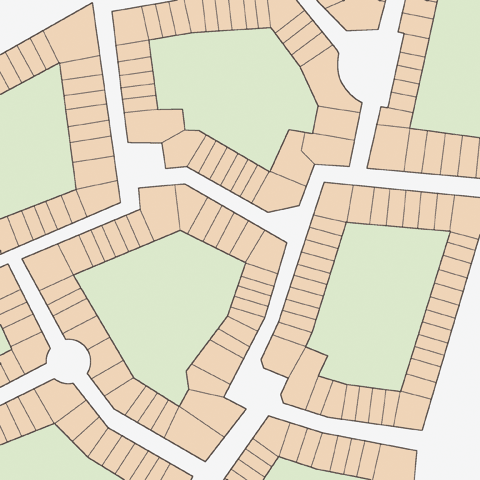 Final Arrangement
The locations of the demising walls that separate one house from the next are determined.
Refinements are made in the shapes of local streets and squares. The layout of streets,
squares, interior courtyards, and building sites is complete.
Hot New LinksThe links below will open in a new browser window:
Poundbury by Francis King Emergent Urbanism blog MITRAC Energy Saver [PDF!] (super-capacitors for rail vehicles) from Bombardier Good practices in Design for Environment: 15 years of experiences at Bombardier Transportation [PDF!]
About Carfree Times
Next Issue
Subscribe to Carfree Times
Write for Carfree Times
|
| Editor | J.H. Crawford |
| Send e-mail | |
| URL | http://www.carfree.com/
|
Back to Carfree.com
Carfree Times Home
Back to Carfree Times Issue 52
Forward to Carfree Times Issue 54
E-mail
carfree.com
Copyright ©2009 J.Crawford
